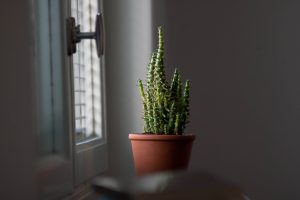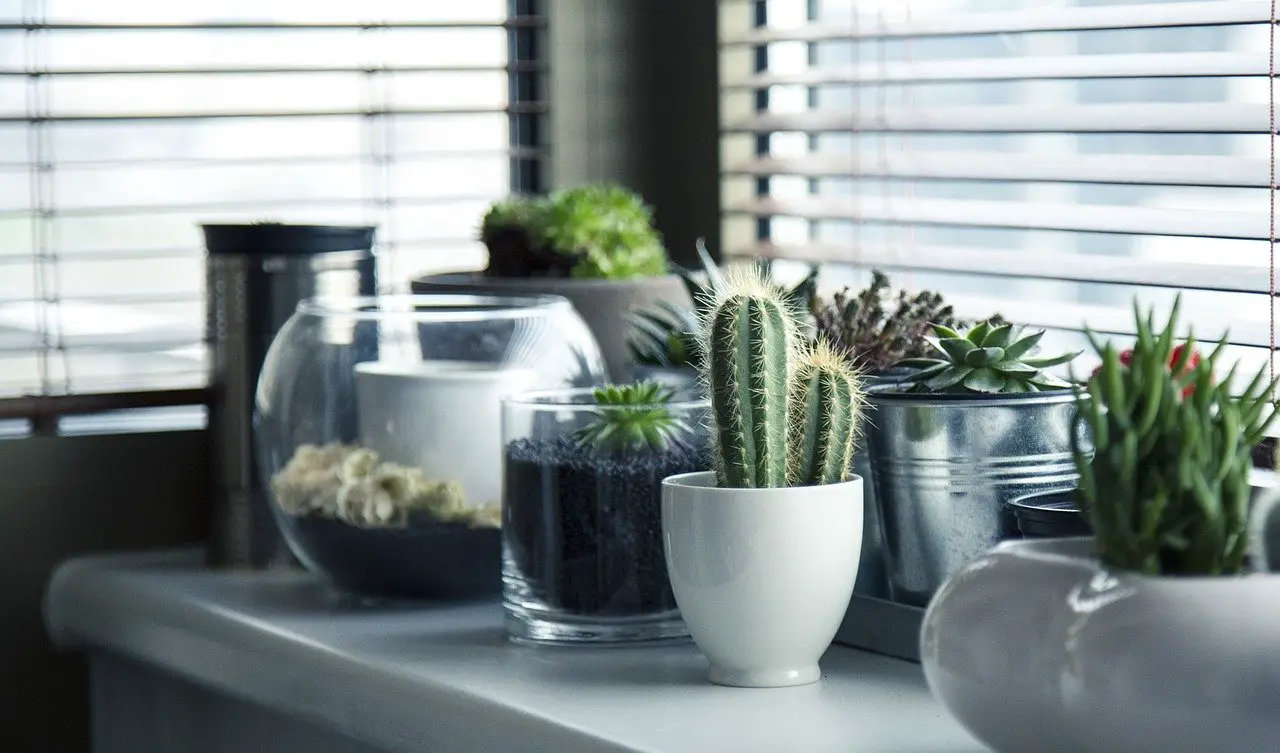Last Updated on April 9, 2024 by Real Men Sow
Cacti are known to need very little water to survive and this myth has caused many to die. Cacti, like all plants, require regular care and love. You will notice if your plant isn’t getting enough water. Shriveling, brittle roots, and leaf discoloration are the most obvious signs of an underwatered cactus along with dry brown spots, dry cactus spines, and leaves curling.
However, there are times when the symptoms of underwatering and overwatering are similar. This is because the roots aren’t receiving enough water in either case. Wilting can occur due to overwatering or underwatering but it would depend on the type and size of the cactus. You can check the roots to determine the difference.

Do You Have An Underwatered Cactus? This is how you check it
Cactus Is Turning Yellow
Your cactus’s body or its leaves turns yellow when it isn’t producing chlorophyll as it should. This could be due to either underwatering or overwatering. Root damage may cause the leaves and body to turn yellow. The roots of your plant are either dying or experiencing drought.
Shriveling
If your cactus doesn’t get enough water, it will shrink. This is because the plant’s tissues are dehydrated.
Wilting
It will occur when the cactus is looking more upright and thin. Because there isn’t enough water in the tissues, it will gradually droop and soften.
Brown Tips with Brown and Dry Edges
Seeing your cactus with a meatier tissue with tips and edges starting to wilt and die from insufficient water. You could also get severe sunburn if you submerge your plant and expose it to the sun.
Dry Brown Spots on Leaves
Your cactus may have dry brown spots on its leaves due to direct sunlight or too much heat. However, they are not sufficiently hydrated to handle it. You are making your plant more vulnerable to heat and sunburn by underwatering it.
Leaves Curling
If you under water your cactus, their leaves may curl because they don’t get enough hydration. As a result, they try hard to retain as much water as they can. This is why their leaves may curl.
Brittle Roots
Brittle roots are another sign of underwatering. Your cactus roots will dry out and become brittle if they don’t get enough nutrients and moisture from the soil. If you tug on them, they will break apart in pieces.
Spines Falling Off
Insufficient water will cause your cactus’ spines to lose strength and shine. They may become fragile and brittle, and could even fall off if touched or left alone.
How to Identify The Cause Of Underwatered Cactus
Irregular Watering of
Tips for watering your cactus more efficiently:
- Watering should be done sparingly, but often, and it should also be done thoroughly and abundantly, so that the entire soil is soaked. Cactus growth can be distorted if it is not watered regularly enough. The soil in the pot should only be moist to half the area, while the lower portion will remain dry.
- Cactus can be shocked if it is watered with cold water, especially during the summer. Your cactus should be watered with room temperature water.
- Use rainwater, filtered water, or distilled water to water your plants. Tap water can contain chemicals that could cause harm to your plants.
- A watering schedule is important. You should check the plant’s moisture regularly, especially during the summer when it may need more water.
- When your plant “wakes up” in late March or early April you can gently mist it with warm water to get it to adjust to its temperature.
- Warm rainwater (or warm distilled water) is recommended for the first spring watering following the end of dormancy. This will ensure that you don’t shock your plant from its long, restful sleep.
Fast Water Evaporation
Cacti are mainly desert plants, but they will not enjoy being in direct sunlight or too close to heaters for long periods of time.
- Your cacti should be kept in indirect, bright sunlight and not too close to heat sources. This can cause the soil to lose more water quickly, which could lead to your cactus becoming dry and shriveled.
- Keep your cactus near a radiator in winter so it doesn’t get too hot.
Soil Mixture Isn’t Suitable
Although good water drainage is important for your cactus’ health, it should also be capable of retaining adequate moisture and nutrients. You must have at least 30% perlite combined with sand. Otherwise, it will remain moist and cause rotting to your cactus. This is the best and most basic soil mix you can make at your home.
- Mix 40% of normal potting soil with 20% perlite, 20% organic compound/humus, 20% coarse gravel, or sand.
- Perlite and gravel/sand leave space between soil molecules, allowing for oxygen to enter. This keeps the soil from becoming too moist, which can be very harmful for a cactus. It also prevents root rot. Cacti get the nutrients they need from organic compost.
Wrong Size and Type of Container
- Place the cactus into a pot that is appropriate for its size. Small cacti shouldn’t be kept in large pots as they won’t absorb water properly. You shouldn’t place large cacti into pots that are too small for them. This will leave no room for their roots.
- Make sure you buy a pot that has drainage holes. Otherwise, excess water could cause root rot.
Nitrogen Toxicity
- Too much nitrogen will encourage cacti to put on soft growth and be more susceptible to pests and diseases. Excessive nitrogen takes water away from your plants while leaving the salt behind. This dehydrates your plant while leaving its leaves brown, yellow, wilted, or curled.
- To avoid this, don’t fertilize your cacti and succulents more than once a month during spring and summer, and don’t fertilize at all during the winter. Let the winter months be a period of rest for your cacti in order to avoid excess salt.
- For cacti, you can also use a granular fertilizer. It is durable, lasts for a long time, and also dissolves slowly which is good for cacti because they absorb food slower than other, regular annual greens.
How to Revive an Underwatered Cactus?
Cut off Severely Affected Parts
Use a sharp, sterilized knife to remove any brown or dry pieces or leaves from your cactus because these parts will not recover, and the plant won’t be able to use them. Do not cut the yellow parts because they are not rotten, rather, they’re dehydrated.
Water the Cactus
Cacti can be watered easily and most will respond to your watering. Allow the cactus to dry completely after watering. If the cactus doesn’t start to grow in a few days you can inspect the roots and investigate further to determine the root cause.
Repot the Underwaterd Cactus in Clean Soil
Cacti should generally be repotted every two years depending on their size. Cacti that are older and larger should not be repotted as often as those that are younger and smaller.
The soil could be the problem if your cacti become dry even after they are watered. If your soil is not right or the cactus is becoming too dry, you can repot it in a new pot. It’s best to use plastic pots because they retain moisture better than any other materials.
Place the Underwatered Cactus’ Pot in A Suitable Environment
- Place the cactus plant in indirect, bright sunlight. Cacti will tolerate some sun, but too much direct light can dry them out.
- Cacti like temperatures between 60°F and 75°F (16–23°C), which are suitable for most homes.
- Avoid heating or using radiators to dry your cacti. They can dry out your plants.
- Cacti can be placed outside in spring and summer, but they should be brought inside when temperatures drop (early Autumn).
- Young plants should not be kept in direct sunlight as they will quickly shrivel up.
How to Water a Cactus Properly?
Watering Cactus from Above
- Place water directly on the soil to avoid getting your cactus moist.
- Watering the soil surface is not enough. Water your plant until the water comes out of the drainage holes at the base. You’re flushing out salt and reducing the chance of your plant wilting or becoming dehydrated.
- Do not pour all of the water at once. You could end up with a pot that is too full and your plant may not absorb the water as it should.
- If there is a saucer underneath the pot, you should empty it after a few minutes (maximum 30 seconds). Do not leave your plant in water too long as it could absorb more water than it needs. This can cause it to rot.
Watering Cactus from Below
You can water your plants from the bottom, which allows your plant to absorb all of the water it needs, reducing the chance of your plant getting too wet.
- Fill a large container with enough water to hold your pot. Your pot should have drainage holes to allow water to flow through.
- The water level should not be too low. Just enough to allow the pot to be submerged in the water (approximately two inches).
- You should keep your plant in its container until the soil becomes moist. This means that water has reached the top of the soil and the plant has absorbed all it needs. This process can take anywhere from 10 to 30 minutes depending on how large your plant is.
- When the soil has absorbed all the moisture, remove the plant from the container and place it back in its original location.
This method of watering can lead to excess salt accumulation and dehydration. The plant absorbs all nutrients and water directly, so the excess cannot drain away. You’ll have to water the plants from the top too, so excess salt can be removed.
How Often Should I Water My Cactus?
It is important to identify the phase of your plant in order to answer this question. You will need to water your Cacti less often and less thoroughly in winter and late autumn. Cacti will then go into dormancy in winter, and won’t take in as much water. Some cacti don’t even require water.
The growth period usually lasts between April and October. Cacti should be watered once per month and fertilized on a weekly basis during this period.
How To Plant Cactus So it’s Not Overwatered
You should water your cactus plants in smaller pots once a week during full growth (late spring or summer). Larger plants in larger pots should be watered every 5 to 7 day during this period. Larger plants in larger pots need to be watered 2-3 times per month. Heat and light influence the amount and time between watering. The more heat and light the soil in the pot dries out faster, so water it more often and abundantly.
Growing and Caring For Your Underwatered Cactus The Right Way
- Learning about the natural habitat of your cactus will allow you to determine when your cactus’ growing season is and what its watering requirements are. Forest cacti such as the Christmas cactus need more humidity and water than desert cacti.
- Before watering, make sure to check the soil’s moisture. Your plant might absorb water more quickly or less frequently than you plan. This can be done in one of two ways: with your finger or with a moisture meter.
- Don’t water if your soil moisture meter shows that it isn’t nearly or completely dry.
- Place your finger about an inch below the soil. If the soil is still moist, it’s probably not the right time to water your plants.

